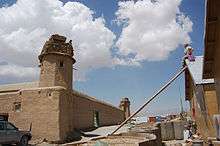Qalat (fortress)

The word qalat (kalata) is Persian[1] and qal'at (qal‘a) is Arabic[2] for 'fortified place'. It frequently occurs in place names. Qalats can range from castles like Rumkale to the mud-brick compound common throughout southwest Asia. The term is used throughout the Muslim world to indicate a defensive fortress.[3] It is even preserved in place names in places such as Sicily which was occupied by the Aghlabid dynasty and then the Fatimids from the ninth to the twelfth centuries.[4]
Qala compounds
In many areas of Iran, Afghanistan and Pakistan, particularly in tribal areas with pre-modern building practices, the qalat compound is the standard housing unit for multi-generational families. Qalats can be quickly constructed over the course of a single season, and they can be extremely large, sometimes covering several acres. Towers may be placed at the corners or points along the walls to create a more defensible position, but most qala compounds consist only of the walls.
While the foundation of a qala compound may be stone or fired brick, the walls are typically dried mud. Walls are created by laying down a row of adobe bricks with mud mortar along the entire length of the wall. By the time that the mason returns to the point of origin, the mortar is dry and the next row can be added on top of the old. Using this technique walls dozens of feet high can be built very rapidly.
Notes
- ↑ For the derivation of the Arabic term from the Persian, see Leslau, Wolf (1987) Comparative dictionary of Geʻez (Classical Ethiopic): Geʻez-English, English-Geʻez, with an index of the Semitic roots Otto Harrassowitz Verlag, Wiesbaden, Germany, page 426, ISBN 978-3-447-02592-8, citing Fraenkel, Siegmund (1886) Die Aramäischen Fremdwörter im Arabischen (The Aramaic Loanwords in Arabic) E.J. Brill, Leiden, The Netherlands, page 237, OCLC 750560476, in German, reproduced from original in 1962 by Georg Olms, Hildesheim, Germany, OCLC 476894716, and again in 1982, ISBN 978-3-487-00319-1 and Belardi, Walter (1959) "Arabo قلعة qal‘a" Annali dell'Istituto Universitario Orientale di Napoli - Sezione Linguistica 1: pp. 147–150
- ↑ Steingass, Francis Joseph (1993) Arabic-English Dictionary Asian Educational Services, New Delhi, page 853, ISBN 978-81-206-0855-9
- ↑ Belardi, Walter (1959) "Arabo قلعة qal‘a" Annali dell'Istituto Universitario Orientale di Napoli - Sezione Linguistica 1: pp. 147–150
- ↑ Influsso arabo: L’elemento arabo è ben attestato, soprattutto in Sicilia, a testimonianza di un dominio, quello saraceno, che durò dall’inizio del IX fino alle soglie del XII secolo. Con il toponimo generico qal‘a (‘cittadella’, ‘fortezza’) abbiamo per esempio Calatafimi, Calatamauro (ovvero ‘la rocca del Moro’), Calatrasi (‘la rocca del tessitore’), Caltabellotta (‘la rocca delle querce’). (Arab influence: The Arab element is well attested, especially in Sicily, evidence of the Saracen rule beginning in the ninth and lasting until the beginning of the twelfth century. From the generic name Qal'a ('citadel', 'fortress') we have, for example: Calatafimi, Calatamauro (i.e. 'the stronghold of the Moor'), Calatrasi ('the fortress of the weaver'), Caltabellotta ('the fortress of the oak trees').) Bentsik, R. "Tracce" ("Traces") "Intercultural Dialogue European Radio Campaign" page 61, www.tatapume.org; see also Pellegrini, Giovan Battista (1974) "Attraverso la toponomastica urbana medievale in Italia" ("Through the medieval urban toponymy in Italy") pp. 401–499 In Centro italiano di studi sull'alto Medioevo (1974) Topografia urbana e vita cittadina nell'alto Medioevo in Occidente, 26 aprile-1 maggio 1973 (Conference publication) Presso la sede del Centro, Spoleto, Italy, volume 2, page 415, OCLC 1857092
Further reading
- Kennedy, Hugh N. (2006) Muslim Military Architecture in Greater Syria Brill, Leiden, ISBN 90-04-14713-6
- Facey, William (1997) Back to Earth: Adobe Building in Saudi Arabia Al-Turath in association with the London Centre of Arab Studies, London, ISBN 1-900404-13-3
- Bing, Judith et al. (1996) Architectural Elements of Traditional Settlements International Association for the Study of Traditional Environments, Berkeley, California, OCLC 37475487
- Szabo, Albert and Barfield, Thomas J. (1991) Afghanistan: An Atlas of Indigenous Domestic Architecture University of Texas Press, Austin, Texas, ISBN 0-292-70419-4
- Hallet, Stanley Ira and Samizay, Rafi (1980) Traditional Architecture of Afghanistan Garland STPM Press, New York, ISBN 0-8240-7059-3
- Mumtaz, Kamil Khan (1983) Traditional Forms of Rural Habitat in Pakistan UNESCO, Paris, OCLC 10606333